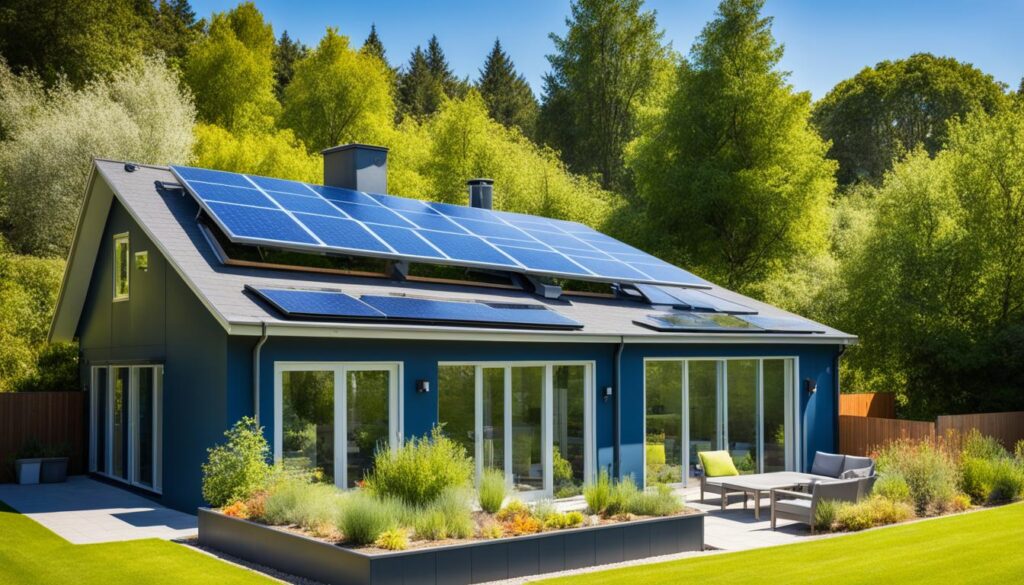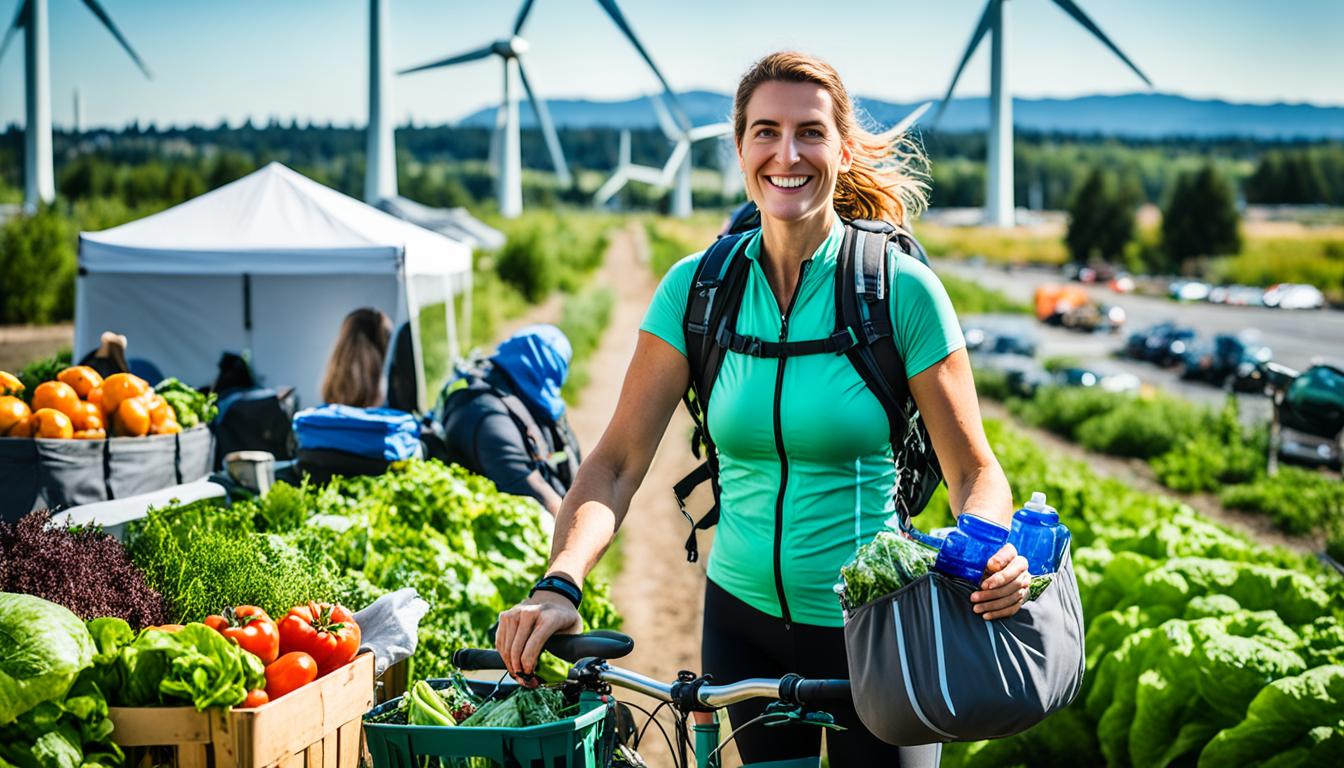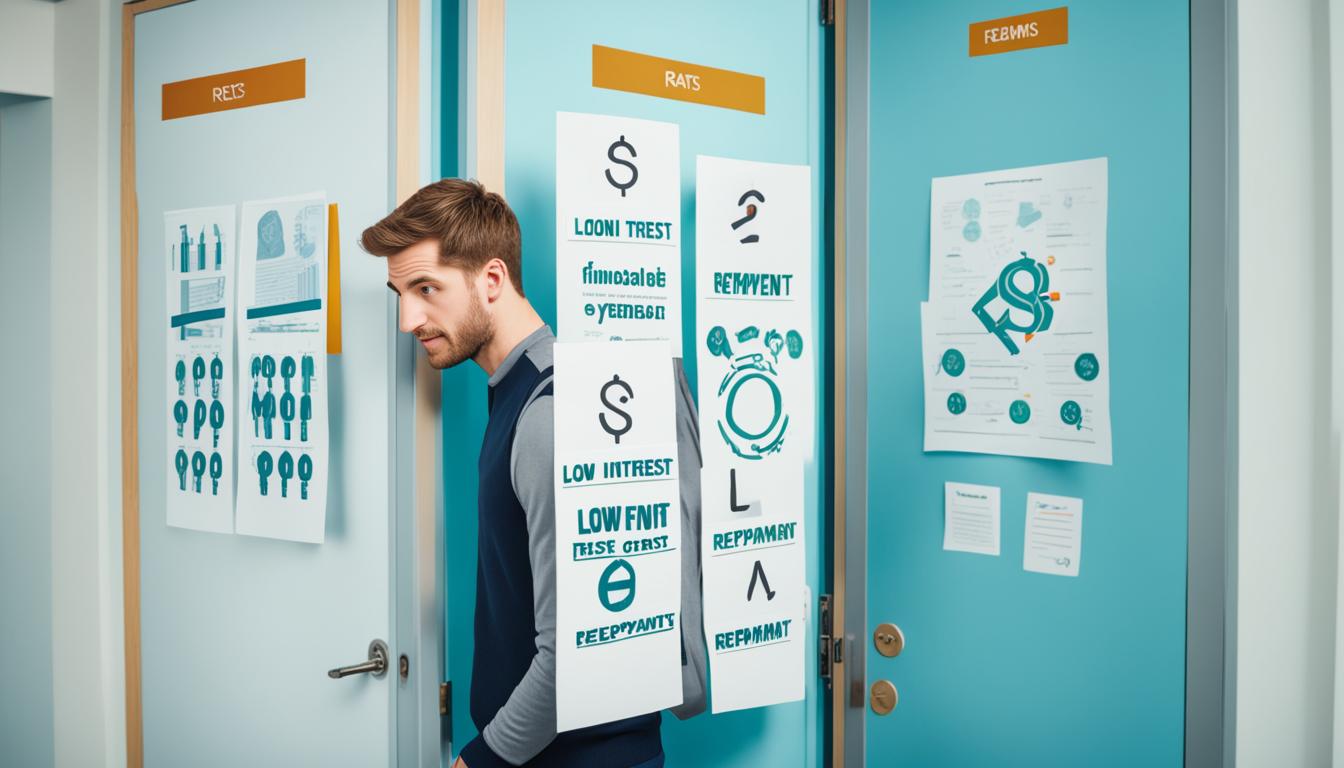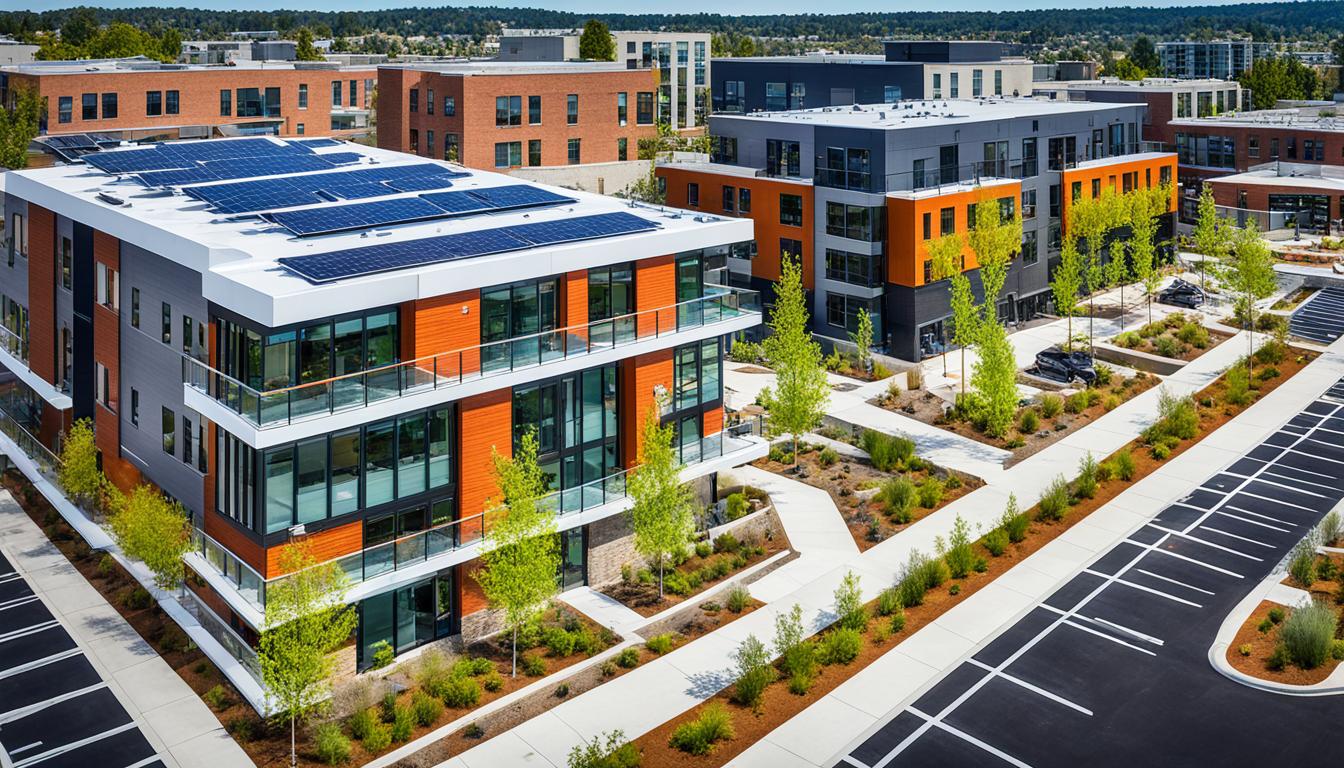Living sustainably means making choices that help the environment. It’s about reducing our carbon footprint. By living this way, we keep the planet green for those who follow us.
Key Takeaways:
- A sustainable lifestyle involves making choices that reduce our environmental footprint.
- By adopting sustainable practices, we can contribute to a healthier planet for future generations.
- Living sustainably means being mindful of our consumption and making eco-friendly choices.
- Reducing waste, opting for sustainable products, and embracing renewable energy are essential aspects of living sustainably.
- It’s important to take action and make conscious choices to create a more sustainable future.
Think Twice Before Shopping
It’s important to think about our planet when we shop. By making thoughtful choices, we can help protect the environment.
Before buying something, ask yourself if you really need it. This simple step can cut down on impulse buys.
Buying secondhand items is a great choice. It keeps products out of landfills and saves you money. Check out thrift stores, online sites, and consignment shops for good deals.
Look for products with little packaging and made from eco-friendly materials. Choosing items like organic cotton or recycled materials can lessen the impact on our planet.
To see the difference, here’s a comparison:
| Environmental Impact Comparison | Purchasing New Items | Opting for Secondhand Alternatives |
|---|---|---|
| Reduce Environmental Footprint | Increased demand for new production | Extends the lifespan of existing products |
| Resource Consumption | Uses raw materials and energy | Utilizes existing resources |
| Waste Generation | Creates packaging waste | Reduces waste from discarded products |
Mindful shopping is good for you and the Earth. It’s about reducing waste and supporting sustainable living.
Ditch Plastic and Switch to Reuse
Our planet faces a big issue with plastic pollution. The high use of single-use plastic items is a main reason. Things like plastic bags, water bottles, and straws are meant to be used once before being thrown away. This creates a lot of plastic waste, much of which ends up in our oceans. This is harmful to sea life and ecosystems.
The best way to fight plastic pollution is by going for reusable products. Choosing items that last a long time reduces our need for single-use plastic. This helps keep our planet safe.
Consider these reusable products to make a good change:
- Reusable Bags: Use cloth or canvas bags instead of disposable ones when you shop.
- Reusable Water Bottles: Keep a refillable water bottle with you to avoid single-use plastic bottles.
- Reusable Straws: Pick stainless steel or bamboo straws instead of plastic ones.
The Impact of Single-Use Plastic
Single-use plastic is a big threat to our environment and animals. These items take hundreds of years to go away. As they do, they become tiny bits of plastic that harm the environment and food chain.
Sea animals can eat these plastics by mistake. This leads to them getting caught or hurt. We see the damage of plastic pollution on our beaches and in the farthest places of our earth.
We can tackle this problem by using less single-use plastic and more reusables. This is a big step in protecting our important habitats and the future of our world.
| Plastic Pollution Facts | Solutions |
|---|---|
| Every year, billions of single-use plastic bags, bottles, and straws are discarded worldwide. | Use reusable bags, water bottles, and straws. |
| Producing and throwing away plastic adds to greenhouse gas emissions and climate change. | Choose products made from materials that don’t harm the planet. |
| Plastic waste in the oceans hurts marine life, like fish and whales. | Help clean beaches and support groups that fight plastic pollution. |
By using reusables and cutting back on single-use plastic, we help fight plastic pollution. This protects our planet’s beauty and the life it supports for the future.
Take Extinction Off Your Plate
The meat industry affects our planet a lot. It uses a lot of water, produces greenhouse gases, and destroys habitats. We should think about eating less meat or going for a plant-based diet to help the Earth.
The Environmental Impact of Meat Production
Farm animals add a lot of greenhouse gases to our air, more than all cars, trains, and planes. They are the reason for 14.5% of the world’s greenhouse gases. We can cut these harmful gases by eating less meat.
Also, meat makes us cut down forests to farm animals. This hurts many plants and animals, leading to fewer species on Earth.
Meat also needs a ton of water. Animals drink a lot and their food needs a lot too. Eating more plants instead can save water.
Choosing Sustainable Food Options
Eating less meat can still be yummy and good for you. There are plenty of plant-based foods and recipes full of nutrients. They can keep us healthy.
Adding more fruits, veggies, beans, and grains to our diet is smart. It helps reduce our harm to the Earth and keeps us healthier. Plus, it means we’re supporting farms that take care of nature.
Here is a table that highlights the differences between a plant-based diet and a typical meat-based diet:
| Plant-Based Diet | Typical Meat-Based Diet |
|---|---|
| Emphasizes fruits, vegetables, grains, legumes, nuts, and seeds | Relies heavily on animal products such as meat, dairy, and eggs |
| Low carbon footprint due to reduced greenhouse gas emissions | High carbon footprint due to methane emissions from livestock and transportation of animal products |
| Conserves water resources by reducing the amount of water used in livestock production | Requires significant water usage in livestock farming |
| Supports sustainable farming practices and biodiversity conservation | Contributes to deforestation, habitat destruction, and loss of biodiversity |
Small changes in our diet can go a long way. Eating more plants or trying Meatless Mondays can help us and the Earth.
Simplify the Holidays
Holiday times bring joy and togetherness but can also cause a lot of waste. They add to harming our planet. Luckily, there are many ways to make our holidays better for the Earth. We can do this by keeping things simple, using eco-friendly decorations, and choosing homemade or used gifts. This makes our celebrations both meaningful and gentle on the environment.
We can simplify our holiday events to make them better for our planet. Instead of lots of decorations and big meals, we should focus on what’s important. This step decreases waste. It also helps us see the real value of the holidays.
Choosing eco-friendly decorations is key to a green celebration. Avoid disposable, plastic decor. Go for natural items you can use again. Think about using pinecones or potted plants. These add beauty to your space and are low-waste choices for celebrations.
For gifts, think about making your own or buying used. Homemade presents are special and show you care. They also cut down on the harm that factory-made items bring. Buying used gifts is good for your wallet and the planet. It helps give products a longer life.
| Benefits of Simplifying the Holidays | Benefits of Using Eco-Friendly Decorations | Benefits of Homemade and Secondhand Gifts |
|---|---|---|
| – Reduces waste | – Minimizes the use of plastic | – Supports a circular economy |
| – Saves money | – Reusable and long-lasting | – Showcases thoughtfulness |
| – Focuses on what truly matters | – Adds a touch of nature and elegance | – Reduces environmental impact |
By simplifying and choosing green practices, we lessen our impact on Earth. We also find the real happiness of the holiday season. It’s about the memories we make, being thankful, and cherishing our connections with others and the planet.
Choose Organic
Making sustainable choices is crucial. When we choose organic, we make a big difference. This applies to food, clothes, and personal care. Organic products support farming that’s free from harmful chemicals. They help keep the environment healthy. Organic farming focuses on soil health, biodiversity, and conservation. This makes it great for us and the planet.
Benefits of Organic Products
Organic products don’t use pesticides. Regularly, farmers use synthetic pesticides that can hurt us and nature. Picking organic lowers our contact with bad chemicals. It also supports farming that cares about our health and the earth.
- Organic food: Going organic means eating food without synthetic pesticides, herbicides, or GMOs. It helps biodiversity and keeps our soil healthy.
- Organic clothing: Fashion often hurts the environment with toxic chemicals. Choosing organic clothing helps. It’s made from eco-friendly materials like organic cotton or hemp.
- Organic personal care items: Many personal care items have bad chemicals. Opting for organic means safer products that are made responsibly.
Buying organic helps a lot. It makes sustainable farming more popular. This supports organic businesses. It also helps keep our soil, water, and air clean. Choosing organic products is key for a better, healthier world for our kids.
Sustainable Farming Practices
Organic farming is about more than no pesticides. It supports the planet’s overall health. Organic farmers do several key things:
- Composting: By composting, they feed the soil naturally. This reduces the need for artificial fertilizers and makes soil healthier.
- Crop rotation: Changing crops helps avoid pests and diseases naturally. This means using fewer chemicals. It also makes the agriculture system stronger and more diverse.
- Water conservation: Organic farming saves water. Methods like drip irrigation and cover crops waste less water. This helps protect water, a vital resource.
- Promoting biodiversity: Organic farms are biodiverse. They keep natural areas, plant cover crops, and create spaces for wildlife. This supports a balance in nature and helps pollinators.
Buying organic is great for us and the planet. It supports health and sustainable farming. It’s a powerful step towards a better and more natural world.
| Benefits | Sustainable Farming Practices |
|---|---|
|
|
Ditch Fast Fashion and Animal-Based Textiles
The fashion industry impacts the environment a lot. This is seen from making textiles to the waste that fast fashion brings. If we go for sustainable fashion and move away from fast trends, we can be more eco-friendly and ethical.
Slow fashion is about getting goods that last. It focuses on buying fewer items but of higher quality. This means creating less waste. It also helps fair work and the use of eco materials.
Choosing cruelty-free textiles is vital. Stuff like fur, leather, and silk often come with harm to animals and the planet. But, we can pick items made from plants, like organic cotton, hemp, and bamboo. This supports a kinder fashion world.
EILEEN FISHER is a great example. They make lasting, quality clothes in a good way. They use sustainable materials and are open about their process. They also check that workers get fair deals and care for the planet.

Making the fashion world greener is a team effort. If everyone moves away from fast fashion and picks ethical, durable, and kind clothes, we can do better for the earth. Let’s all pick fashion that’s good for us and for our world.
Be Water Wise
Water conservation is key for battling droughts and cutting water usage. We can save water by taking shorter showers and fixing leaks. Choosing drought-resistant plants for our gardens helps too.
Xeriscaping makes gardens beautiful and water-saving. It picks plants that suit the local weather and need less water. This way, we can have a lovely garden with less effort.
Rainwater collection is a great idea. It saves rain for use in the garden. That’s water we don’t need to use from the tap.
Smart sprinklers are also helpful. They water plants when they really need it. This stops plants from getting too much or too little water.
These steps help save a lot of water. They make our world better for the future.
Drive Less, Drive Green
Using gas vehicles leads to a lot of greenhouse gas emissions. But, we can drive our way to a healthier planet. By picking greener ways to get around, we lower our carbon footprint.
Walking and cycling are great for both your health and the planet. They don’t add any extra CO2 to the air. Making these a part of your day helps cut down on harmful greenhouse gases.
Sharing a ride with friends through carpooling is smart. It means fewer cars are out there polluting. Plus, it saves everyone money on gas.
Taking the bus, train, or tram does a lot of good. These public transport options are much greener than driving alone. They help our cities breathe better.
Table: Comparison of Carbon Emissions by Transportation Mode
| Transportation Mode | Carbon Emissions (grams CO2 per passenger-mile) |
|---|---|
| Bicycle | 0 |
| Walking | 0 |
| Carpooling | 184 |
| Public Transportation | 168-268 |
| Private Car | 325 |
The table clearly shows how to cut carbon. 🌎 By choosing greener ways, we can make a big difference. This helps keep the air clean for everyone.
Electric cars are another big step towards cleaning up the planet. They don’t throw out emissions. As more of them are on the road, we do less harm to our atmosphere.
We all must do our part by choosing green. 🌲 By driving less and sharing the road, we protect our planet. Let’s build a future where we all can breathe easy.
Green Your Home
Making your home more energy-efficient is vital for sustainable living. Using sustainable home practices and renewable energy lowers our environmental impact. It also helps in building a greener tomorrow.
Switching to energy-saving lightbulbs is an easy step. These lightbulbs use less electricity and last longer. They greatly reduce our power use. Also, making sure our homes are well-insulated keeps energy from escaping and helps us stay cozy.

Using renewable energy sources is another great way to go green. By adding solar panels to our roofs, we can use the sun’s power to make electricity. This cuts down on using fossil fuels and saves us money on bills.
It’s also about daily habits. Remembering to turn off lights and unplug electronics helps a lot. Using natural cleaning products is good for both our homes and the earth. These small steps reduce our energy use and impact our planet less.
Benefits of Greening Your Home:
- Lower energy bills
- Reduced carbon emissions
- Decreased reliance on fossil fuels
- Improved indoor air quality
- Contribution to a sustainable future
Choosing to focus on energy efficiency and sustainable home practices is key. It makes our living space more eco-friendly. Plus, it helps in the big effort to fight climate change and keep our world safe for the future.
Conclusion
Living sustainably is key to fight climate change. It’s about making smart choices every day. We must act now for a better future on Earth.
Taking small steps like careful shopping, reducing waste, and eating more plants helps. Together, we can lower climate change effects. These steps improve our world and our health.
Sustainability is a team effort. Even the tiniest actions count. Everyone can help. Let’s keep making sustainable choices and encouraging others. This way, we’ll build a better, greener future together.
FAQ
How can I live sustainably?
Living sustainably is about making choices that help the environment. It means cutting our carbon footprint. This action ensures we leave a healthy planet for future people.
What should I consider before making a purchase?
Before buying something, think if you really need it. Choose secondhand when you can. Look for goods with little packaging and are eco-safe. This cuts down on waste and harm to our Earth.
How can I reduce plastic waste?
Plastic harms our planet. Start by not using plastic once, and using reusables instead. Bags, bottles, and straws that are reusable save marine life from plastic dangers.
What impact does the meat industry have on the environment?
The meat industry harms our Earth a lot. It uses a lot of water, sends out greenhouse gases, and ruins habitats. Eating more plants or less meat cuts our individual harm and helps Earth’s health.
How can I have eco-friendly holiday celebrations?
Happy times can mean a big mess for the Earth. Celebrate in ways that use less and reuse more. Make your own decorations and gifts to be kinder to our planet.
How does choosing organic products help the environment?
Going organic means using fewer harmful chemicals. It’s good for food, clothes, and personal care. Organic farming respects nature, making it a better choice for us and the planet.
What is slow fashion and why is it important?
Fast fashion hurts the environment and workers. Slow fashion is all about less, quality, and green, clean materials. By choosing this, we support a better fashion industry.
How can I conserve water in my daily life?
Water is precious, and saving it is key. Taking quick showers and fixing leaks at home help. Also, using plants that need less water in our yards saves a lot.
How can I reduce my carbon footprint in transportation?
Transportation harms the air a lot. Walking, biking, sharing rides, or public transport are green choices. They help our planet and make transportation better for everyone.
What are some ways to make my home more energy-efficient?
Energy-saving in our homes matters. Changing to eco bulbs, insulating, using solar power, and green daily habits are big helps. They save energy and money, and protect the planet.
What can I do to contribute to a more sustainable future?
Being green is for all of us. Shopping smart, reducing waste, eating more plants, and less meat are steps. These actions by each person help our world now and for those who come after us.


















